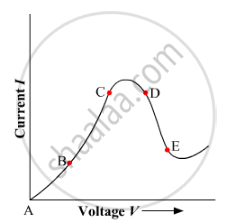Advertisements
Advertisements
Question
Two cells each of 5V are connected in series across an 8Ω resistor and three parallel resistors of 4Ω, 6Ω, and 12Ω. Draw a circuit diagram for the above arrangement. Calculate
- the current drawn from the cell
- current through each resistor
Solution
i) Current drawn from the cell
Eeq = 5+5 = 10V
Reff = Rs+ Rp
Rs = 8 Ω
`1/"R"_"p" = 1/4 + 1/6 + 1/12`
`= (18 + 12 + 6)/72 = 36/72`
∴ Rp = `72/36` = 2 Ω
Reff = 8 + 2 = 10Ω
I = `"E"_"eq"/"R"_"eff" = 10/10 = 1`A
∴ I = 1A
Voltage drop V= IR =1 × 2 = 2V
V = 2V
ii) Current through each resistor:
∴ current in 4Ω resistor
I = 24 = O.5A
I = O.5A
current in 6Ω resistor, I = `2/6` = 0.33 A
I = 0.33A
current in 12Ω resistor, I = `2/12 = 1/6` = 0.17A
I = 0.17A
APPEARS IN
RELATED QUESTIONS
Graph showing the variation of current versus voltage for a material Ga As is shown in the figure. Identify the region of
(i) negative resistance
(ii) where Ohm's law is obeyed.

When a 12 V battery is connected across an unknown resistor, there is a current of 2.5 mA in the circuit. Find the value of the resistance of the resistor.
A low voltage supply from which one needs high currents must have very low internal resistance. Why?
SI unit of resistance is:
State macroscopic form of Ohm’s law.
What is ohmic device?
Which of the following I-V graph represents ohmic conductors?
You are provided with a resistor, a key, an ammeter, a voltmeter, four cells of 1.5 V each and few connecting wires. Using circuit components, draw a labelled circuit diagram to show the setup to study Ohm's law.
State the relationship between potential difference (V) across the resistor and the current (I) flowing through it. Also draw V-I graph, taking V on the X-axis.
Let the resistance of an electrical device remain constant, while the potential difference across its two ends decreases to one fourth of its initial value. What change will occur in the current through it? State the law which helps us in solving the above stated question.
How is electric current related to the potential difference across the terminals of a conductor?
Draw a labelled circuit diagram to verify this relationship.
